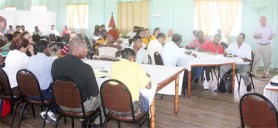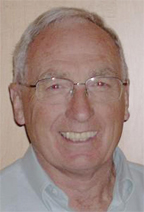By Marlon Munroe
Canadian consultant and specialist in the long term development of athletes Dr. Colin Higgs commenced a three-day expert training programme for administrators of sport associations yesterday at the Carifesta Sports Complex and reminded the participants that Guyana does not exist in a “static sport system.”

The seminar is also part of the Sport Ministry’s plan to notify the associations that the long awaited National Sports Policy is in the process of being finalised.
Dr. Higgs told administrators that there should be flexibility on their part and the time is now for attitudes and beliefs to be changed.
He pointed out to them that with the presentation of the document they will realise that champions are not accidental and therefore they should be looking to improve how things are done.
During yesterday’s break Stabroek Sport spoke with Dr. Higgs about what the document entails and how it will benefit Guyana.
These were some his responses:
MM: Based on your expertise, what are some of the most important components of the document and how much work was done during your visit in March?
CH: I started the development of the National Sports Policy plan back in March. There was some very good ground work that people had done before that and then I had a meeting with the key stakeholders: with (ministries of) education, sport, with the individual sport associations to listen to what they wanted and then put it altogether into a plan. That plan has five components (enhance) excellence, (enhance) participation, (enhance) social development, building capacity and better delivery.

For each of those, there is a list of tasks that need to be accomplished. The National Sport Council (Commission) has a role to play; individual national sport organisers have a role to play; Ministry of Education and school sport has a role to play. There is then a target date when these (tasks) are to be completed by.
MM: What is the timeline for completion and are there specific sports which must show a particular trend of development?
CH: It is a five-year plan but not everything is to be done by the end of the five years. There are not specific sports but rather the policy talks about the sport system and there might be a lead organisation; it identifies a role for sports.
There is nothing that is specific to one sport this is about the whole system. And part of that is going to be working with sports (associations) to try to develop their own Long Term Developmental Plan (LTDP).
MM: What should be part of the associations’ roles?
CH: The role of the associations is to say that this is how we are going to implement the programme in our sport system. So, the last thing that we have for each of these tasks is its performance indicator. ‘How would we know when this has been done?’ This would be in terms of the athletes, certifying coaches, some of it is to do with developing officials, facilities and infrastructure.
It is a very broad plan as it has to be with those five objectives. That part I have been working on with the minister, the NSC and the associations. Part of that also was to say that we need to rethink how sports develop their specific athletes. Therefore we had to introduce this concept of Long Term Athlete Development (LTAD) to the sporting community here.
MM: In a third world country such as Guyana where sport is often not on the front burner, what are your recommendations if the policy is to achieve any success?
CH: One of the things that I spent a lot of time putting together and is in the report is what I would call ‘the cost benefit of investing in sport’. If you invest in sport you save money as a country!
Two very simple examples: data worldwide says that every dollar you spend in sport and recreation you save three dollars in health care costs; (2) and in crime reduction there is some data that show for every dollar you spend on sport for high risk populations you can save $40 on police and prison costs since it is expensive to keep people in prison.
But you can reach youth through sport and give them life skills and employment skills and they can have a non-criminal life and save a lot of money. That is my approach: you need to invest in sport so that you can save money in other parts of that economy.
MM: Guyana, enjoying an extremely rich sporting history and then falling by the wayside can you pinpoint some of the reasons for this stark decline especially when it seems that local administrators seem to be reinventing the wheel?
CH: We (They) are trying to reinvent the wheel and I make no apologies about that. Secondly, how can I answer that question, probably there is a political answer.
MM: Oftentimes local sport administrators think that presenting gear and building a facility is development what would say to them now that there is the National Sports Policy?
CH: I would say it is part of development but it is not the whole picture. The whole picture of development is what I will spend today (yesterday) and tomorrow (today) talking about. Also, what is needed for children and youths at each stage of their development to give them the opportunity to reach the very top.
What you need to do for an athlete at every stage of his development is also included in the document because different strategies are needed at the different stages. Additionally, the shortcomings, not only of Guyana’s sport but of sport in general, is that we (coaches) do the same thing with nine-year-olds that we do with the 19-year-olds: we give them the same drills, we play the game in exactly the same way and that is not the way to develop talent.
MM:With all the factors affecting developing countries, do you believe implementation and eventual success will result?
CH:Why not! Yes! The information is there and it is really a matter of changing people’s attitudes and their beliefs. In Canada, we have made information free and available online. So somebody in a national sport organisation should access this information, if they are interested.
MM: As an aside, can you say what might have been responsible for Jamaica’s success on the world scene?
CH: I cannot answer that question in any detail but I will say be careful how you interpret what has happened there. Jamaica has not had across-the-board success. They have been very successful in a relatively narrow range of activities and that narrow range of activities is based a very large extent on athletics.
(Further) There is the gravitation to track and field and quite often it is about what is attractive within a particular environment. It is also about having systematic training and they have a very structured track and field development process, which takes a focused approached.




